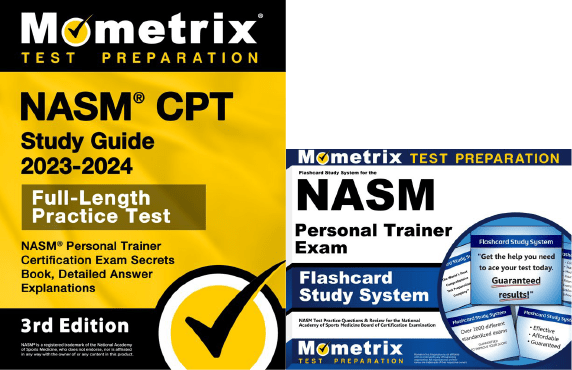If you need help studying for the NASM Certified Personal Trainer (CPT) exam or just want some more information about what the test is like, you’ve come to the right place.
Click below to take a free CPT practice test!
Exam Eligibility
Before you can register to take the NASM CPT exam, you’ll need to have graduated from high school or have your GED. You’ll also need a current CPR/AED certification, which you can get through NASM.
If you meet these requirements, you’re set to begin the registration process!
What’s on the Exam?
First, let’s talk about the questions on the exam. There are 120 multiple-choice questions total, but only 100 of the questions will count toward your score. Why is that?
The 20 unscored questions on the exam are called “pretest” questions. These are added to the exam to determine if they’re good enough questions to add to future versions of the test.
The trick is that you won’t have any way of knowing which questions are scored and which ones are pretest. They will appear just like the scored questions throughout the test.
The time limit for the exam is 2 hours. There aren’t any scheduled breaks, but you’re free to take restroom breaks as needed.
Let’s take a closer look at the different sections of the NASM CPT exam.
1. Basic and Applied Sciences and Nutritional Concepts
15% of the exam
- Concepts and structures of anatomy
- Functions of exercise physiology
- Functional biomechanics
- Principles of human movement science
- Principles of motor development
- Macronutrients and micronutrients
- Hydration concepts and guidelines
- Guidelines for caloric intake and expenditure
- Energy systems
- EPOC
- Dietary reference intakes
- Portion sizes and meal timing and frequency
- Nutrient and energy density
- Crash/fad/myth diets
- Common nutritional supplements
- Food and supplement label reading
- Factors that can influence weight management physiology
2. Client Relations and Behavioral Coaching
15% of the exam
- Establishing and maintaining professional client-trainer relationship
- Developing short-term and long-term goals with the client
- Facilitating lifestyle and behavioral change
- Communication methods and strategies
- Goal types
- Client expectation management
- Transtheoretical Model of Behavior Change
- Behavioral coaching methods and behavioral change strategies
- Barriers to behavior change
- Psychological responses to exercise
3. Assessment
16% of the exam
- Selecting, performing, documenting, and interpreting results of subjective assessments
- PAR-Q assessment
- Essential elements of personal, occupational, and family medical history
- Medical risk factors
- Elements of a lifestyle questionnaire
- Cardiorespiratory assessments
- Physiological assessments relevant to CPTs
- Kinetic chain checkpoints
- Applicability of assessments from other health professionals
- Body composition assessments and calculations
- Static postural assessment
- Performance and movement assessments
- Modifications for performing assessments with special populations
- Outcome expectations for special populations
- Indicators that a client’s condition requires a medical release/clearance
- Criteria for reassessment
4. Program Design
20% of the exam
- Designing and modifying a client-specific program
- Periodization concepts, programming, and methods
- Principles of specificity, variation, and overload
- General adaptation syndrome
- Flexibility training methods
- Resistance training systems and modalities
- Cardiorespiratory training methods
- Core training and balance training exercises
- Proprioceptive progression and regression
- Reactive training exercises
- SAQ training exercises
- Acute variables
- Risk vs. reward of different modalities and exercises
- Overtraining, rest, and recovery
- Current trends
- Types of fitness technology
5. Exercise Technique and Training Instruction
24% of the exam
- Providing instruction and demonstrating proper exercise technique
- Providing feedback on a client’s exercise technique
- Implementing appropriate exercise progressions and regressions
- Administering safe, effective, and professional spotting techniques
- Proper set-up and technique of various training methods and exercises
- Kinesthetic, auditory, and visual cueing techniques
- Safe training practices
- Signs that indicate need for training modification or discontinuation
- Proper breathing techniques
6. Professional Development and Responsibility
10% of the exam
- Adhering to applicable professional standards
- Developing and growing business
- Following proper safety and emergency protocols
- Engaging in continuing education and professional development
- Requirements for maintaining professional credentials
- Marketing concepts and techniques
- Client acquisition, retention, and ascension
- Sales concepts and techniques
- Equipment maintenance and safety
- Credible resources of information regarding health and fitness education
How to Register
Once you’ve ensured that you meet the eligibility requirements, you can register for the exam!
To get started, you’ll need to submit an application on NASM’s website. The application will ask you for your contact information and any documentation to prove your eligibility (among other things).
When you submit the application, you’ll also need to submit the testing fee, which is $599.
Exam Scores
The NASM CPT exam is scored using a scaled scoring method. Here’s how it works:
For every question you answer correctly, you get one point added to your raw score. At the end of the test, your final raw score will be converted to a scaled score. This scaled score will range somewhere between 0 and 100.
The reason your raw score is converted to a scaled score is because everyone that takes the test is given a slightly different set of questions. Since everyone has a different arrangement of questions, and because some questions are harder than others, converting your raw score to a scaled score ensures a more even playing field.
Retaking the Exam
If you didn’t get a passing score on your first try, that’s okay! You can retake the test after a one-week waiting period. If you fail on your second try, you’ll have to wait 30 days before taking it again.
FAQs
How many questions are on the NASM CPT exam?
The exam contains 120 multiple-choice questions.
What is the time limit for the NASM CPT exam?
The exam is timed at 2 hours.
What is the passing score for the NASM CPT exam?
You’ll need a final score of at least 70 to pass.
How much does the NASM CPT exam cost?
The testing fee is $599.



 CPT Study Guide
CPT Study Guide CPT Flashcards
CPT Flashcards